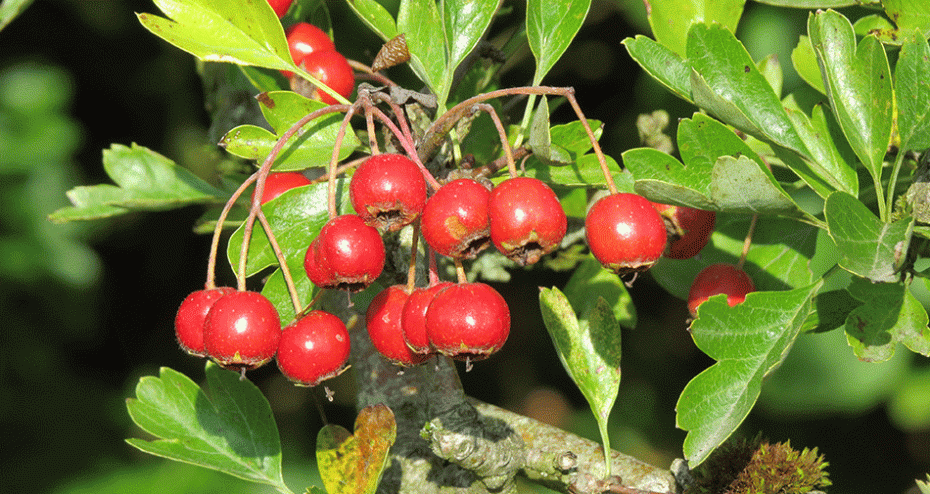Create interest in the autumn garden and provide for wildlife
This year, 2022, is the Queen’s Platinum Jubilee, 70 years on the throne, and to commemorate this momentous event she is encouraging us to plant a tree, under the premise of The Queen’s Green Canopy. There are many species of trees and there is sure to be one to suit every situation, from the smallest backyard to an extensive estate. Many trees can be grown in containers or are suitable for the typical urban garden. The trees mentioned in this article all bear fruit or berries in the autumn and are an important source of winter food for birds and small mammals. Many of the fruits also make delicious jams and jellies. Crab apple jelly is particularly delicious on toast or as an accompaniment to meat dishes such as lamb, poultry and game. Rowan jelly also makes a mouth-watering jelly to accompany meat or cheese and who doesn’t love a drop of sloe gin in the depths of winter.
Apples (Malus sylvestris)
There are masses of apple varieties from which to choose and which ones you go for depends upon the amount of space you have. If you only have a small garden, patio or balcony then opt for one of the patio varieties which have 2 – 3 varieties on one plant. They pollinate each other so you don’t need another tree. If you buy a single variety tree check whether it is self-fertile or not, if not you will need another tree which flowers at the same time. If you live in an urban area where there are other trees you may have one nearby which can pollinate your tree. Fan trained trees which go against a wall are also an excellent choice for a small garden as are step-over trees which are exactly what they say, usually two pairs of branches trained horizontally which are low enough to step over. These make a beautiful edge to raised vegetable beds.
Blackthorn, sloes (Prunus spinosa)
These are not usually grown as a stand-alone tree but as part of a mixed native wildlife hedge. They make an excellent security hedge as they have vicious spikes, so not suitable if you have children. The sloes in winter make an excellent gin.
Cherry (Prunus sp.)
There are many varieties of sweet cherries or if you want to do your bit for wildlife plant the native Wild Cherry, Prunus avium, which is loved by the birds in autumn. However, it does grow to be a large tree so not one for a small space.
Crab apple (Malus)
There are plenty of crab apple trees on the market, many of them suitable for a small garden or large container. Fruit colour ranges from the deepest wine red to rich golden yellow and flower colour ranging from palest pink to deep carmine.

Malus Profusion (pictured)
Elderberry (Sambucus nigra)
Not only do you get a bounteous crop of berries in the autumn but masses of flowers in early summer which make a delicious refreshing elderflower champagne. It was typically taken into hayfields to refresh the workers toiling under the hot sun.
Spindle, common (Euonymus europea)
This beautiful tree produces orange seeds surrounded by bright pink berry which splits into four sections to reveal the seed underneath. It is a large tree so not one for the small garden and does need an alkaline (lime) soil. The leaf colour in autumn ranges from yellow to dark red, depending upon environmental conditions.
Hawthorn (Crataegus monogyna) (main image)
This medium sized native tree is one of the best for wildlife producing masses of berries in autumn which are an important source of winter food for the birds. There are cultivated varieties available with deep carmine flowers. Not one for the container but in a medium sized garden the lower branches can be removed to allow more light into the understorey. If you have a garden which gets battered by coastal winds this tolerant tree would be ideal.
Quince (Cydonia oblonga)
This is a medium sized tree so not one for a container. The yellow pear-shaped fruits are strongly aromatic and as such shouldn’t be stored next to other fruit in winter. They don’t last well once picked, 6 – 8 weeks, so should be made into jams and jellies or bottled within this period.
Pears (Pyrus communis)
These trees require the same conditions as apples and also come in the same patio, fan-trained and step-over forms.
Rowan, Mountain Ash (Sorbus aucuparia)
These medium sized native trees are one of the mainstays of the birds winter larder, producing masses of berries. Ornamental forms are available which have pink, snow white and golden berries.


